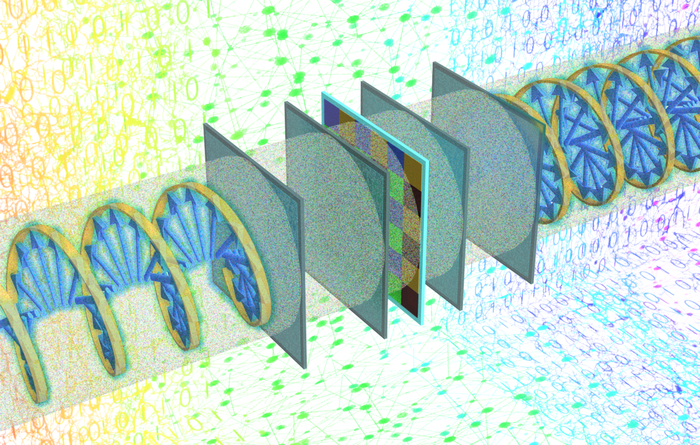Implementing large-scale linear transformations or matrix computations plays a pivotal role in modern information processing systems. Digital computer systems need to complete up to billions of matrix operations per second to perform complex computational tasks, such as training and inference for deep neural networks. As a result, the throughput of linear transform computations can directly influence the performance and capacity of the underlying computing systems. These linear transformations are computed using digital processors in computers, which can face bottlenecks as the size of the data to be processed gets larger and larger. This is where all-optical computing methods can potentially provide a remedy through their parallelism and speed.

Credit: by Ozcan Lab @ UCLA
Implementing large-scale linear transformations or matrix computations plays a pivotal role in modern information processing systems. Digital computer systems need to complete up to billions of matrix operations per second to perform complex computational tasks, such as training and inference for deep neural networks. As a result, the throughput of linear transform computations can directly influence the performance and capacity of the underlying computing systems. These linear transformations are computed using digital processors in computers, which can face bottlenecks as the size of the data to be processed gets larger and larger. This is where all-optical computing methods can potentially provide a remedy through their parallelism and speed.
In a recent study published in Light: Science and Applications, researchers from the University of California, Los Angeles (UCLA) have demonstrated a polarization-encoded diffractive optical processor to enable high-speed, low-power computation of multiple linear transformations using only the diffraction of light. This optical processor utilizes a series of structured diffractive surfaces and simple polarizer arrays, which can jointly manipulate the input light and generate, at the output plane, the result of any desired complex-valued linear transformation of the input field. A major advantage of this all-optical diffractive processor over its conventional electronic counterparts is that, except for the illumination light, it does not need any computing power and can be scaled up to handle large input data by fabricating wide-area wafers that compute in parallel. In addition, all the computation is completed at the speed of light propagation through a thin diffractive volume, making the execution of complex-valued linear transformations extremely fast.
This research was led by Professor Aydogan Ozcan from the Electrical and Computer Engineering Department and California NanoSystems Institute (CNSI) at UCLA. This new optical architecture introduces a polarization encoding mechanism that allows a single diffractive processor to perform up to four different linear transformations through polarization multiplexing of information. By enabling the structured surfaces to communicate with the polarization elements embedded in the diffractive volume, a single diffractive optical processor can implicitly form multiple distinct computation channels, each of which can be accessed using a specific combination of the input and output polarization states. After being trained through data-driven approaches such as deep learning, the diffractive processor can all-optically compute a group of complex-valued linear transformations, which can be assigned to perform different computational tasks for different polarization combinations, including, for example, image classification, segmentation, encryption, and filtering operations. This unique design allows a single diffractive optical processor to be loaded with a diverse range of tasks simultaneously, enhancing the multifunctionality of optical information processing systems.
According to the UCLA research team, their polarization-encoded diffractive optical processor can work at different parts of the electromagnetic spectrum due to the versatility of its design. Since it can directly process the phase and amplitude information of an input scene, this design is particularly suitable for applications in visual computing and can be used to construct intelligent passive optical front-ends for machine vision systems. Furthermore, the inherent capability of this system to process input polarization information of a sample or scene might also enable its applications in polarization-aware optical imaging and sensing, which could be transformative for certain biomedical applications such as the detection of birefringent crystals in bodily fluids.
The other authors of this work include graduate student researchers Jingxi Li, Yi-Chun Hung, Deniz Mengu and postdoc scholar Dr. Onur Kulce, all from UCLA School of Engineering and CNSI.
Journal
Light Science & Applications
DOI
10.1038/s41377-022-00849-x




